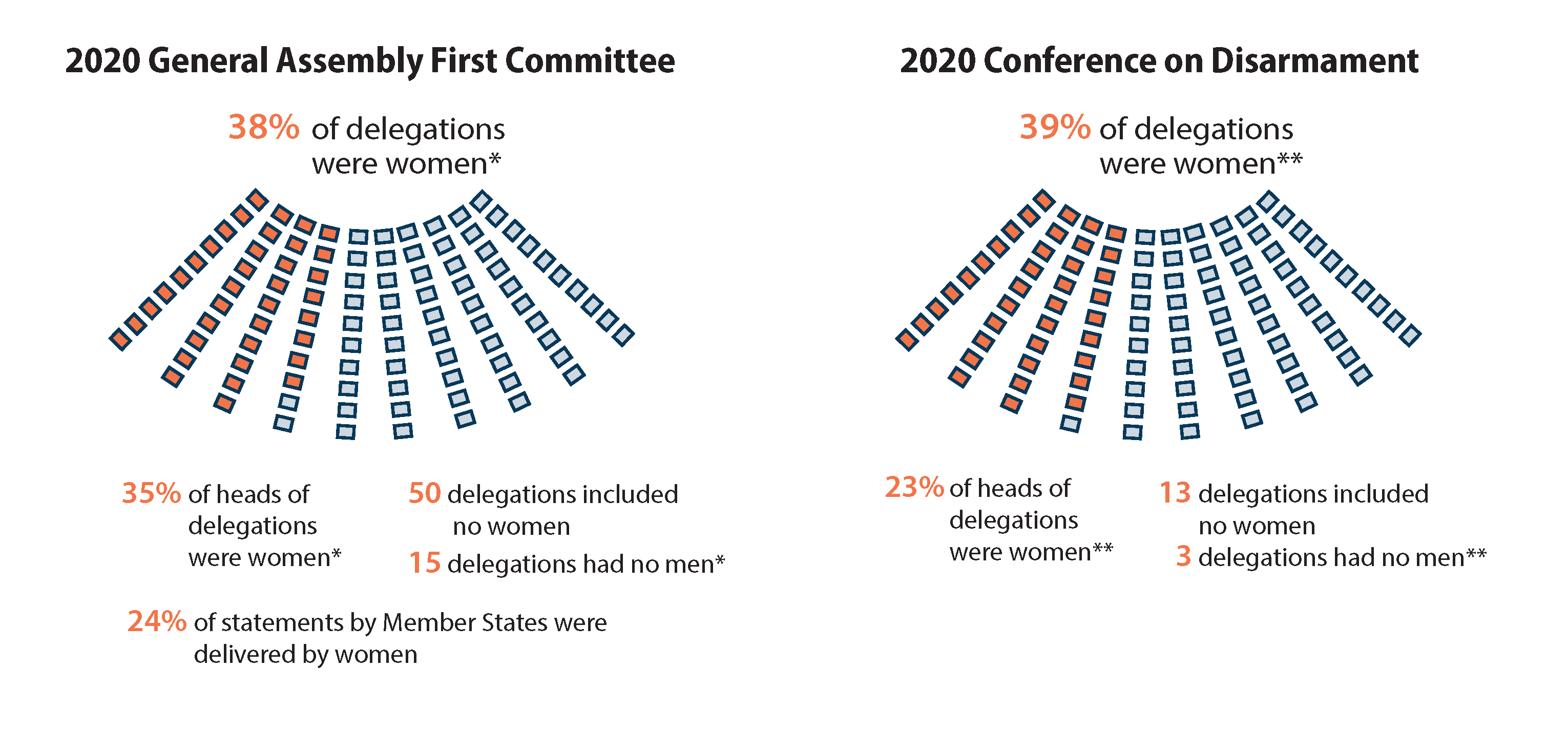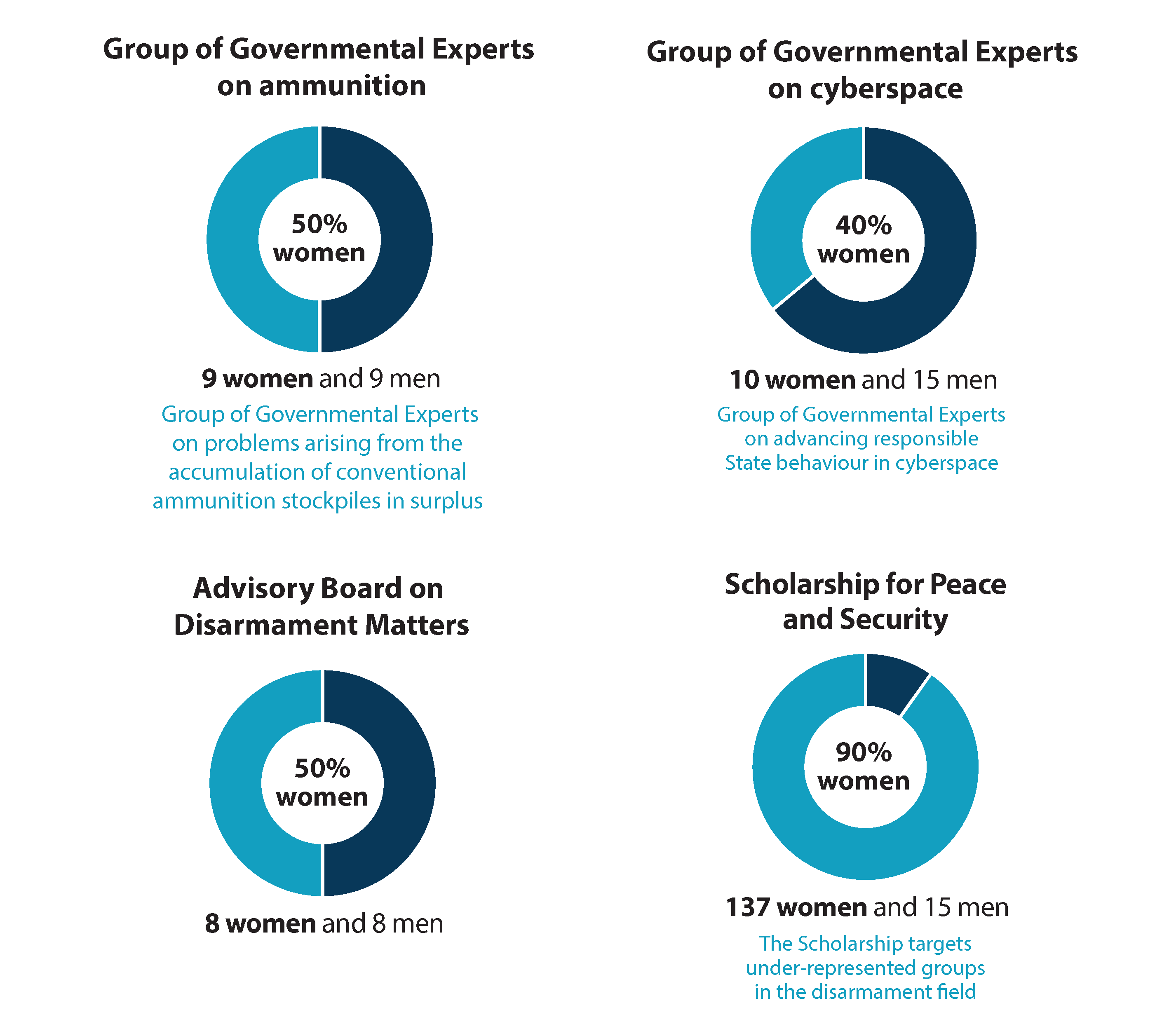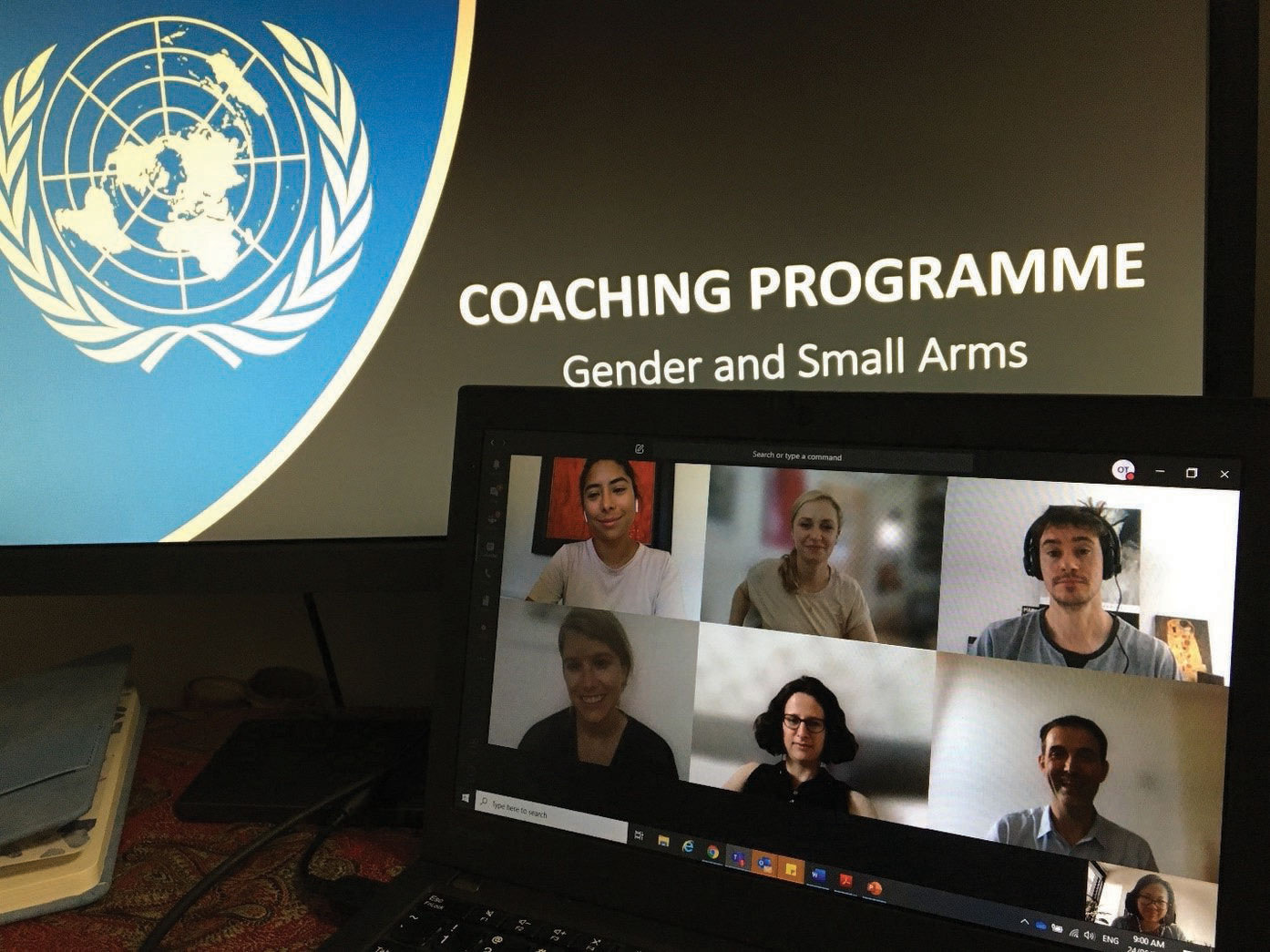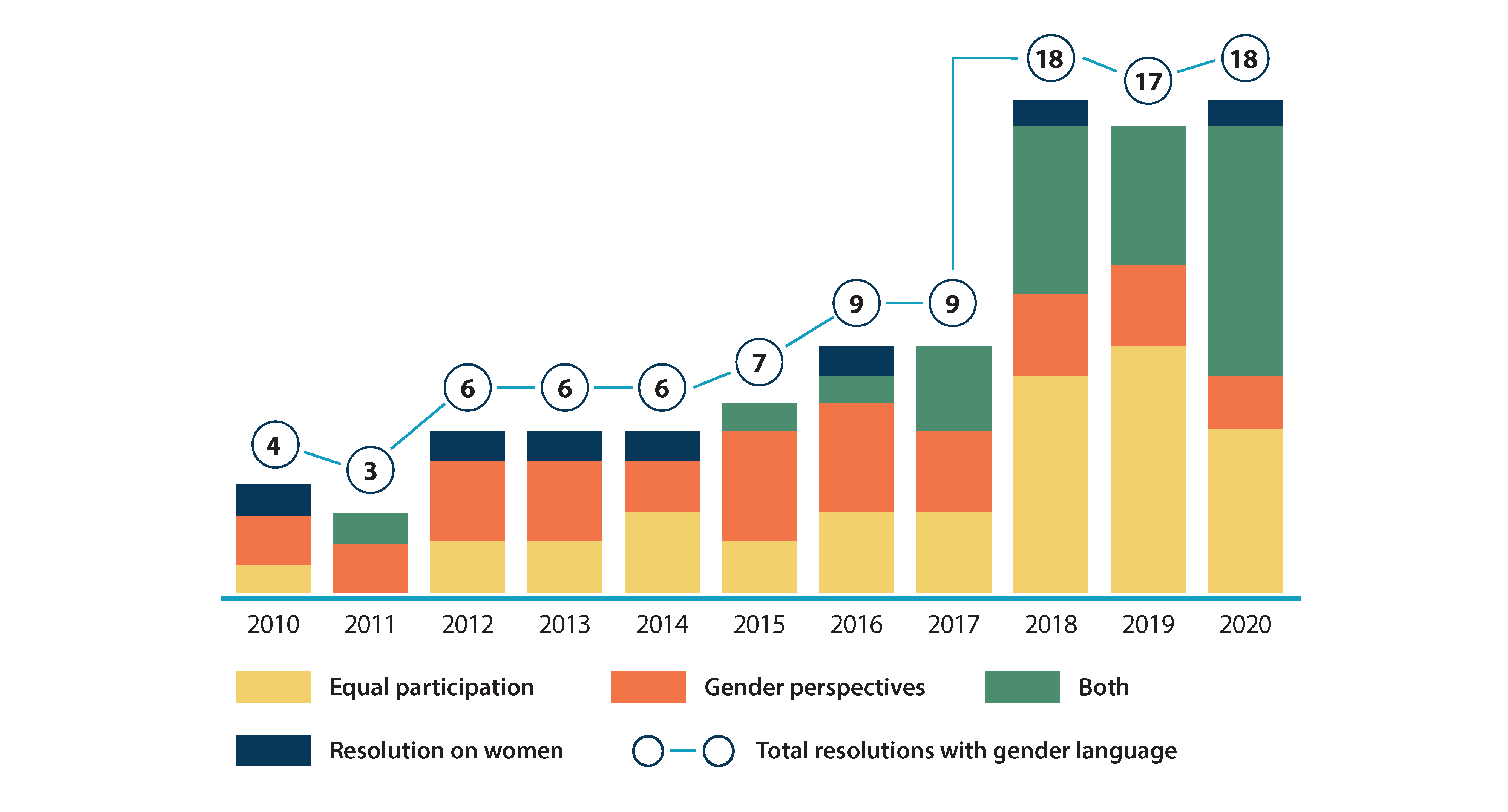A new approach to disarmament should recognize and address the gendered impact of different weapon types and systems and the impact certain weapons have on the prevalence of gender-based violence. It should underscore that ensuring the equal, full and effective participation of women in all decision-making processes related to disarmament is essential for the promotion and attainment of sustainable peace and security.
In 2020, the world marked major anniversaries for three key contributions to gender equality and women’s participation in disarmament: 20 years since the adoption of Security Council resolution 1325 (2000) on women, peace and security; 10 years since the General Assembly adopted resolution 65/69 on women, disarmament, non-proliferation and arms control; and 25 years since the adoption of the Beijing Declaration and Platform for Action, following the fourth World Conference on Women.
However, public health restrictions during the COVID-19 pandemic limited the opportunities to discuss linkages between gender equality and disarmament. Meanwhile, as Governments around the world imposed stay-at-home orders in response to the pandemic, the Secretary-General called for action to address a “horrifying global surge in domestic violence” directed towards women and girls, underscoring the urgency of efforts to utilize arms control as a means of reducing gender-based violence.
In that context, the international community sought to continue promoting women’s leadership and full and effective participation in disarmament processes, including virtual meetings. It also endeavoured to strengthen analysis and approaches aimed at advancing the role of gender-responsive disarmament in pursuing sustainable peace and security for all.

In 2020, women remained under-represented as leaders and participants in multilateral disarmament forums, despite calls by Member States, the United Nations and civil society for the equal, full and effective participation of women in all decision-making in disarmament. On International Women’s Day on 8 March 2020, the High Representative for Disarmament Affairs suggested in a podcast that all Member States pledge to send gender-balanced delegations to multilateral disarmament meetings. In her opening statement at the seventy- fifth session of the General Assembly First Committee, she highlighted that women remained chronically underrepresented in decision-making and leadership and called for accelerating progress on the issue by setting standards and ensuring accountability in reaching parity targets.
* Including one-person delegations. Owing to COVID-19, physical presence in the sessions was reduced. (Source: First Committee list of participants (A/C.1/75/INF/2))
** Out of a total of 64 delegations. (Source: Conference on Disarmament list of participants (CD/INF.79/Rev.2))
The year 2020 marked the tenth anniversary of the General Assembly resolution on “Women, disarmament, non-proliferation and arms control” (65/69), sponsored by Trinidad and Tobago. In December 2020, the Assembly adopted the seventh resolution on this subject (75/48). In the resolution, the Assembly encouraged the promotion of women in decision-making, reaffirmed the full and effective participation of women in disarmament as an essential factor for sustainable peace and security, and called for the empowerment of women, including through capacity-building efforts. It links this area with several other frameworks, including Security Council resolution 1325 (2000) on women, peace and security; the Beijing Declaration and Platform for Action; the Arms Trade Treaty; the 2030 Agenda for Sustainable Development; and the Secretary General’s Agenda for Disarmament. In celebration of the resolution’s anniversary, the United Nations Regional Centre for Peace, Disarmament and Development in Latin America and the Caribbean launched in December 2020 the fourth edition of its Forces of Change publication, featuring more than 80 women in disarmament in Latin America and the Caribbean.
Source: United Nations Regional Centre for Peace, Disarmament and Development in Latin America and the Caribbean, Forces of Change (United Nations publication, 2020).
The Office for Disarmament Affairs continued throughout the year to integrate gender considerations into all its activities, while also undertaking targeted initiatives to help Member States integrate gender perspectives and elements of the women, peace and security agenda into their disarmament and arms control activities. In that regard, the Office achieved further progress in its flagship project on gender and small arms and light weapons. In addition, it continued to promote and monitor progress towards the equal, full and effective participation of women in disarmament forums, a prerequisite to tackling new global challenges and to fully exploring how gender intersects with other identities that risk leading to exclusion in the field of disarmament. The Office also undertook a study on disability, disarmament and arms control, laying the groundwork for an internal action plan on disability inclusion.

In his 2018 Agenda for Disarmament, the Secretary-General called for the full and equal participation of women in all decision-making processes related to disarmament and international security, and he committed to working to achieve gender parity in all panels, boards, expert groups and other bodies established under his auspices in the field of disarmament. In 2020, both the Group of Governmental Experts on problems arising from the accumulation of conventional ammunition stockpiles in surplus and the Advisory Board on Disarmament Matters achieved gender parity. A second Group of Governmental Experts, on advancing responsible State behaviour in cyberspace, had 40 per cent women experts. The Scholarship for Peace and Security targets women and under-represented groups to support a pipeline of disarmament leaders and experts.

Office for Disarmament Affairs staff complete, in April 2020, the coaching programme on gender and small arms and light weapons, run by the Office’s Conventional Arms Branch and the United Nations Development Programme’s South Eastern and Eastern Europe Clearinghouse for the Control of Small Arms and Light Weapons.
The United Nations Institute for Disarmament Research (UNIDIR) took a lead role in raising awareness and pursuing policy-relevant research about the gender dimensions of disarmament, including impacts of weapons use that differ by gender, as well as the enduring gender imbalance in multilateral disarmament forums. Through its dedicated gender and disarmament programme, established in 2018 to help diplomats apply a gender lens to their work on disarmament, UNIDIR produced research and proposed practical ideas to further incorporate gender considerations in specific processes for arms control, building on existing expertise in the disarmament field. In 2020, the Institute’s work under the programme included briefings on gender for attendees of important disarmament- related meetings, including a regional workshop in Uganda, tailored to national practitioners from African countries. In addition, UNIDIR produced resources on key topics in arms control and disarmament, while also continuing to regularly update its gender and disarmament online resource hub. In 2020, the online hub attracted 1,634 views per month on average.
Additionally, the Geneva-based International Gender Champions Disarmament Impact Group continued to promote gender perspectives in disarmament. Working with UNIDIR, the Group launched an updated version of the Gender and Disarmament Resource Pack for Multilateral Practitioners, a publication covering the relevance of gender perspectives to arms control, non-proliferation and disarmament, as well as practical ideas for diplomats to apply a gender lens to their work. (For more information on the UNIDIR gender and disarmament programme, see chap. VIII.)
By the end of 2019, 84 States had adopted a total of 143 national action plans, 57 of which contained one or more references to disarmament or arms control.*
The diagram below shows the years in which those 57 plans were adopted.
October 2020 marked 20 years since the Security Council adopted resolution 1325 (2000), its first resolution on women, peace and security. In later years, the Council adopted nine supporting resolutions on the topic.
Disarmament and arms control converge on all pillars of the women, peace and security agenda, a matter explored through webinars, articles, social media outreach and other activities in 2020. Of the 143 national action plans on women, peace and security, which 84 States had adopted by the end of 2019, 57 national action plans (as shown above) contain references to themes related to disarmament or arms control, according to the United Nations Institute for Disarmament Research.
In 2020, the United Nations Regional Centre for Peace and Disarmament in Asia and the Pacific supported the preparation of Nepal’s second national action plan on women, peace and security by suggesting the inclusion of disarmament-related elements.
* For the purposes of this illustration, a “reference” is a use of one of the following terms: small arms and light weapons, the Arms Trade Treaty, landmines, cluster munitions or other explosive remnants of war, weapons of mass destruction or cyberwarfare.
Abbreviations: DRC=Democratic Republic of the Congo; NAP=national action plan.
Source: United Nations Institute for Disarmament Research, “Connecting the Dots”, 2020.

Resolution on women: The first women, disarmament, non-proliferation and arms control resolution (65/69) is adopted in 2010, followed by successors in 2012 (67/48), 2013 (68/33), 2014 (69/61), 2016 (71/56), 2018 (73/46) and 2020 (75/48)
Participation: Gender parity, women’s participation, role or representation
Gender perspectives: Substantive gender aspects and mainstreaming, including the gendered impact of weapons and gender-based violence
Both: References to both of the above
The graph above excludes resolutions with secondary references to gender (e.g., Sustainable Development Goals and Arms Trade Treaty).
When the first resolution on women, disarmament, non-proliferation and arms control (65/69) was adopted in 2010, only three other First Committee resolutions referred to gender or women. In the subsequent years, gender perspectives were brought into an increasing number of other disarmament areas, with a notable leap in 2018 when the General Assembly adopted 18 First Committee resolutions that included mentions of gender perspectives or women’s participation. In 2020, the total number of such resolutions remained at 18. The only new paragraph on gender equality that year was introduced in the new resolutions on reducing space threats, in which the importance of the full involvement and equal participation of women and men and the need to assess the differentiated impacts of such threats were recognized. During the year, the United Nations Office for Disarmament Affairs produced gender-mainstreaming guidance, including an information session for the Office’s staff to support consistent and meaningful gender language in First Committee resolutions.